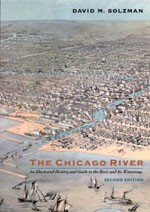Swimming in the Chicago River? Da Mare says it’s not likely

On Tuesday, news broke that the Obama administration had written a letter in April to the Illinois Pollution Control Board calling for efforts to make the Chicago River safe for swimming. Mayor Daley responded, with his characteristic verbal finesse, advising the feds to “go swim in the Potomac.” By Thursday, the Metropolitan Water Reclamation District, the official body who oversees the river, chimed in, claiming, according to the Chicago Tribune, that “making the Chicago River safe enough for swimming would waste taxpayer money and put children at risk of drowning.” The MWRD also said “the river has been altered so dramatically that new efforts to improve water quality would not be worth the costs.”
In addition to being dyed green every year to celebrate St. Patrick’s Day (an effect achieved using orange dye), the Chicago River is most famous for having had its flow reversed in the nineteenth century (the river now runs away from the lake). But has the waterway been changed too much to make it healthy for swimming? The debate seems to have stopped at da Mare’s door, but if you are curious to read more about the river, we recommend paging through David M. Solzman’s The Chicago River: An Illustrated History and Guide to the River and Its Waterways, Second Edition.
With The Chicago River, Solzman has succeeded in writing an encyclopedic work—at once guidebook and history—that explores the river’s physical character and natural history. Examining the river’s past, contemplating its present, and forecasting its future, Solzman draws on his unparalleled knowledge to point out places of scientific and historic interest—involving everything from infamous murder cases to invasive zebra mussels. The book’s 200 photographs and maps perfectly complement Solzman’s vivid prose, leading readers on a visual journey as sinuous as the river it celebrates—a journey interspersed with plenty of river lore, facts, and literary quotations.
Solzman, a veteran Chicago River tour guide, has also compiled a diverse collection of easy and enjoyable tours for anyone who wants to experience the river by foot, boat, canoe, or car. And he provides an appendix that lists river-related organizations, museums, tours, and riverfront restaurants and clubs.
Whether or not you’re keen to do the breaststroke under the Michigan Avenue Bridge or are happy simply to watch the boats and barges glide by from above, the Chicago River—both its history and its future—impacts all who call the city home. David Solzman’s book can help us better appreciate this suddenly contentious natural landmark.